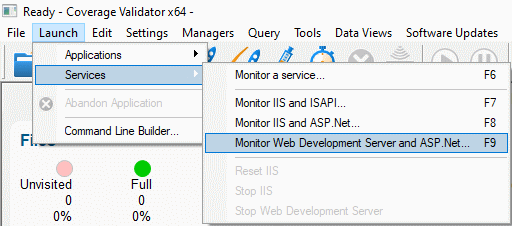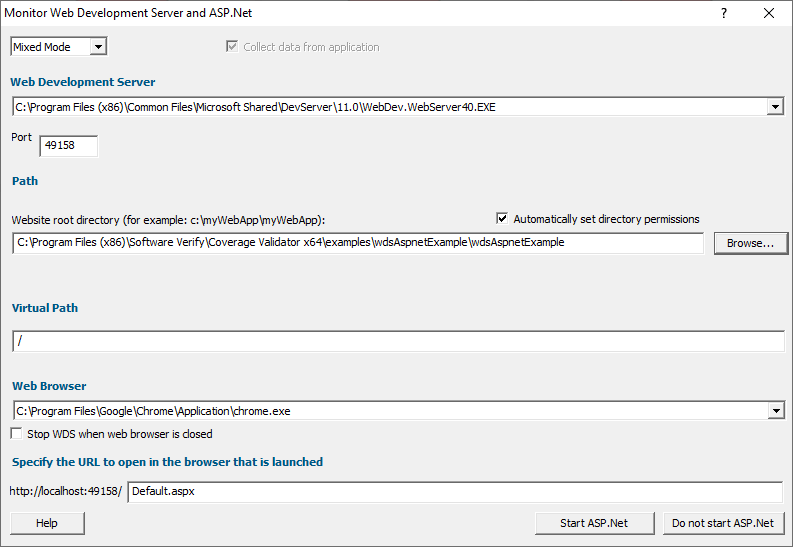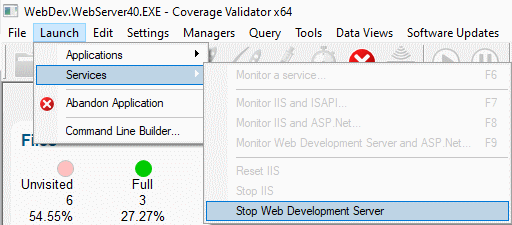Coverage Validator Tutorials

The Tutorials

Getting Started

Why is Coverage Testing Important?

Static Linking MFC and CRT

Dynamic Linking MFC and CRT

Code Coverage Sample Application #1

Code Coverage Sample Application #2

Collecting code coverage in a child process

Getting code coverage for a .Net Core application

Getting code coverage for a .Net Core application child process

Code Coverage for a service

Code Coverage for a service child process

Collecting code coverage in an IIS ISAPI DLL

Code Coverage of ASP.Net with IIS

Collecting code coverage for ASP.Net with Web Development Server

Getting Code Coverage for a Dynamically Linked Library

Getting Code Coverage for a Statically Linked Library

Excluding Code Coverage for a Dynamically Linked Library

Excluding Code Coverage for a Statically Linked Library

Wizard Mode/Dialog Mode.

Interactive Profiling

Merging Samples

Automatic Merging

Command Line

Regression Testing

Identifying Unused Code
Collecting code coverage for ASP.Net with Web Development Server
This tutorial describes how to collect code coverage in ASP.Net applications tested on Microsoft’s Web Development server.
Related tutorials:
Code coverage for a .Net Core application.
Code coverage for a .Net Core application child process.
Code coverage for a service.
Code coverage for a service child process.
Code coverage for an IIS ISAPI DLL.
Code coverage for ASP.Net with IIS.
Code coverage for ASP.Net with Web Development Server.
Example Web Application
An example web application to use with this tutorial is in <Coverage Validator install directory>\examples\wdsAspnetExample\wdsAspnetExample\.
Load \examples\wdsAspnetExample\wdsAspnetExample\wdsAspnetExample.csproj and build the configurations or build wdsAspnetExample.csproj as part of the examples.sln solution.
Collecting code coverage in the ASP.Net web application
- Choose the Launch > Services > Monitor Web Development Server and ASP.Net… option.

- The Monitor Web Development Server and ASP.Net dialog is displayed.

- Select the web development server you wish to use, and the port number. The defaults are chosen to represent the most recent version installed on your machine.
- Choose the appropriate native/mixed-mode/.Net option to specify which types of code you want to collect code coverage for. Mixed-mode is the default, as this collects code coverage for all types of code.
- Select the path to the folder containing web application.
- Specify the virtual path that this folder represents. The default is the root of the website: /
- Select a web browser of your choice. For this example we’ll choose firefox.exe.
- Specify the URL that is going to be loaded from the web application. The default is Default.aspx
- When you click OK, Coverage Validator will set up everything needed to interact with the Web Development server, the web browser will be started to load the specified URL.
- Coverage Validator will instrument your ASP.Net application and start collecting memory allocation data.
The first time you start the web development server you may find that the web browser fails to open the web page because it takes longer to serve the page due to the code coverage monitoring. If this happens just wait a few seconds then reload the page in the web browser.
Stopping Web Development Server
When you have finished testing your ASP.Net application you need to stop Web Development Server so that all .Net operations can conclude.
If you had selected Stop WDS when web browser is closed on the Monitor Web Development Server and ASP.Net dialog then you have nothing to do.
Otherwise, choose Launch > Services > Stop Web Development Server

Web Development Server will be requested to stop. This may take 30 seconds or more.
When Web Development Server stops, Coverage Validator will finish collecting code coverage and prepare its final collect code coverage reports.
I’m not getting any code coverage data. What can I do?
There are a few things to check.
- Check the diagnostics tab. If the NT Service API is working correctly, Coverage Validator will have some data. Information on instrumentation failures will be on the diagnostic tab.
- Check the debug information dialog. You can access this from the Tools > DLL Debug Information… menu. This dialog will tell you which DLLs have debug information and which do not. Any DLLs that don’t have debug information you’ll need to ensure that debug information is built for these DLLs and is findable.
Conclusion
You have learned how to use Coverage Validator to monitor ASP.Net applications using the Web Development server, and what to look at to diagnose errors if things don’t work first time.